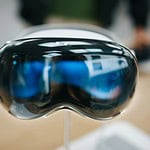The recent buzz about Apple’s next-gen headset may need a reality check – with new tariffs on Chinese imports, analysts now say the Apple Vision Pro 2 won’t arrive until 2026, not late 2025 as once hoped. The combination of supply chain challenges and tariff pressures has pushed back Apple’s timeline for releasing a more affordable version of its spatial computing headset by several months.
While many tech fans hoped for a quicker follow-up to the original $3,499 Vision Pro, Apple now faces tough choices about manufacturing and pricing. Reports from Bloomberg suggest the Vision Pro 2 will keep a similar design but include an upgraded M5 processor. Some sketchy rumors even hint it could cost half as much as the current model.
Bank of America analysts expect Apple to work hard to manage its supply chain to reduce tariff impacts, but the $20 billion hit can’t be ignored. This delay gives Apple more time to refine features and perhaps find ways to bring costs down while dealing with the new economic reality of higher tariffs on Chinese-made goods.
Analysts Now Expect No New Vision Pro in 2025
Hopes for the Apple Vision Pro 2 arriving in 2025 have all but faded after recent analyst updates and a fresh round of U.S. tariffs on Chinese tech components. While Apple hasn’t officially commented, the outlook has changed drastically: instead of a second-gen headset or even a more affordable model launching this year, reports now point to 2026 as the earliest possible window for new Vision hardware.
Leading Apple analyst Ming-Chi Kuo recently noted that Apple appears to have no plans to launch new Vision hardware in 2025, a sharp pivot from earlier expectations. Kuo, along with other analysts like Ross Young, now believes Apple is instead focusing on optimizing the original Vision Pro experience and broadening its international availability.
Tariffs Reshape Apple’s Mixed Reality Strategy
The driving force behind this change? Tariffs. The U.S. government’s updated trade policy includes new restrictions on Chinese-made components critical to the Vision Pro’s production — such as micro-OLED displays, camera modules, and advanced processors. These new costs are throwing a wrench into Apple’s plans to scale the Vision lineup more affordably.
Apple had reportedly been working on a cheaper version of the Vision Pro with fewer sensors, lower resolution displays, and a lighter design. The goal was to bring the price closer to $1,500–$2,000, down from the original’s $3,499 launch price. However, with rising component costs due to tariffs and limited supplier alternatives outside China, that price target may no longer be realistic without significant compromises.
A New Timeline: 2026 and Beyond
With 2025 now off the table, the spotlight shifts to 2026. Sources suggest Apple is still actively developing the budget-friendly headset, but has adjusted its roadmap to account for higher production costs, component shortages, and broader economic uncertainties. The new estimated window for release is mid to late 2026, assuming no further disruptions.
This adjusted timeline also gives Apple more space to develop visionOS into a mature, full-featured operating system with better third-party app support and tighter integration with iOS, macOS, and tvOS. We’re likely to see new features introduced through software updates and perhaps accessories that extend the Vision Pro’s capabilities — but not brand-new hardware this year.
Meta, Samsung, and Others Now Have a Window
The delay could open the door for rivals like Meta to seize more of the mainstream AR/VR market. The Meta Quest 3 is already priced significantly lower, and a Quest 4 is rumored to be on the horizon. Samsung is also working on a high-end headset powered by Google’s platform, set to be unveiled later this year.
Apple’s long game in spatial computing is still very much alive, but this shift signals a more measured, software-focused phase of development rather than a rapid hardware rollout. For consumers waiting on a more affordable Apple headset? Patience just became the name of the game.
Key Takeaways
- Apple Vision Pro 2 release is now expected in 2026 instead of 2025 due to new tariffs on Chinese imports.
- The next headset may cost significantly less than the current $3,499 model while featuring improved processor technology.
- Tariff challenges are forcing Apple to rethink its manufacturing strategy and product timeline for its entire lineup.
Impact of Tariffs on Apple’s Product Timeline
Apple’s plans for the Vision Pro 2 are facing significant delays due to the newly implemented tariffs. These trade policies are reshaping manufacturing decisions, driving up costs, and forcing the company to reconsider its product release schedule.
Influence of Tariffs on Manufacturing and Supply Chain
The proposed tariffs threaten to compound pressure on Apple’s entire business model. With components coming from various countries, the company faces a complex challenge in reorganizing its supply chain.
Apple had been expanding production beyond China before these tariffs, but even these diversification efforts are now impacted. The tariffs will affect products assembled in Vietnam, India, and other countries where Apple has moved operations.
The Vision Pro 2’s specialized components require precise manufacturing processes. These processes are now more expensive and complicated to manage with the new trade barriers.
Apple executives are weighing options like relocating more assembly to the United States, but such changes take time and significant investment.
Price Increase Concerns and Consumer Demand
Analysts predict Apple would need to raise prices by at least 30 percent to offset the tariffs’ impact. For the already expensive Vision Pro, this creates a major pricing challenge.
The first-generation Vision Pro’s $3,499 price point was already a barrier for many consumers. Adding tariff-related increases would push the Vision Pro 2 beyond what most consumers would consider reasonable.
Market research indicates consumer demand for AR/VR headsets is highly price-sensitive. Apple’s original plan for a lower-cost Vision Pro 2 now seems impossible under current conditions.
Some experts suggest Apple might absorb part of the cost increase to maintain demand, but this would significantly impact profit margins.
Adjustments to Apple’s Release Schedule
Apple is completely revamping its product timeline in response to these challenges. The Vision Pro 2, originally expected in late 2025, is now being rescheduled for 2026.
This delay gives Apple time to either negotiate exemptions similar to those it secured during the previous administration or redesign its supply chain to minimize tariff impacts.
Engineers are reportedly reworking the Vision Pro 2’s components to reduce costs and offset some tariff effects. This includes sourcing more parts from countries with lower tariff rates.
The company is prioritizing its core iPhone and Mac lines in the short term, as these generate the bulk of Apple’s revenue. Specialty products like the Vision Pro are being moved further down the timeline.
Industry Response and Market Predictions
The tech industry and financial markets have shown mixed reactions to Apple’s Vision Pro 2 delay. Analysts cite tariff impacts as the main factor pushing the launch into 2026, with significant implications for Apple’s product roadmap and investor expectations.
Analysts’ Views on Revised Launch Estimates
Financial experts have adjusted their timelines for the Vision Pro 2 following recent tariff announcements. Bank of America Securities analysts have already cut their price target on Apple stock to $250 from $265, though they maintained a buy rating despite the headset delays.
Supply chain analysts point to manufacturing challenges that have been worsened by the new tariffs. With a 20% blanket tariff now affecting components, Apple faces tough choices:
- Absorb the cost (reducing margins)
- Pass costs to consumers (risking sales)
- Relocate production (causing delays)
“The 2026 timeline gives Apple breathing room to readjust supply chains,” notes one industry expert. Most analysts agree the extra development time will likely result in a lower-priced headset that could reach more customers.
Comparative Analysis with Other Apple Products
The Vision Pro delay fits a pattern seen with other Apple products facing similar challenges. The iPhone lineup, already dealing with 20 percent tariffs, has maintained its release schedule but with price adjustments to offset costs.
Unlike the iPad, which has more flexible manufacturing options, the Vision Pro’s specialized components make production shifts more complicated. Apple’s strategy with these products offers clues about the Vision Pro 2:
Apple Product Tariff Responses:
| Product | Strategy | Timeline Impact |
|---|---|---|
| iPhone | Price increases | Minimal delay |
| iPad | Partial production shifts | Short delays |
| Vision Pro | Complete timeline revision | 1+ year delay |
Market data shows demand for the original Vision Pro slowing in the US, giving Apple time to perfect the next version.
Investor Confidence Amidst Product Delays
Wall Street remains cautiously optimistic despite the Vision Pro 2 delay. Analyst Wamsi Mohan predicts a potential $1.24 drop in earnings per share by 2026 if Apple absorbs all tariff costs, but many investors view this as manageable.
The political dimension adds complexity. Trump’s tariff policies directly impact Apple’s timeline, creating uncertainty that markets typically dislike. Yet Apple stock has remained relatively stable, suggesting investors trust the company’s long-term vision.
Portfolio managers cite three reasons for continued confidence:
- Apple’s history of successful product launches even after delays
- The company’s strong cash position to weather tariff impacts
- The potential for a more refined Vision Pro 2 with wider appeal in 2026
Small shifts in investor sentiment remain tied to both tariff news and hints about Apple’s progress on a lower-cost headset design.
Frequently Asked Questions
Apple’s Vision Pro 2 faces significant delays and changes due to recent tariff announcements. These shifts affect everything from pricing to release dates and market positioning.
What impact have tariffs had on the release timeline of Apple Vision Pro 2?
The new tariffs have pushed back the Apple Vision Pro 2 release substantially. Originally expected in late 2025, the headset now appears to be on track for a 2026 launch.
Apple’s supply chain plans have been disrupted by the tariff situation. Manufacturing costs have increased, forcing the company to rethink its production timeline.
Mid-2025 mass production plans now appear delayed as Apple adjusts to the new economic reality.
What are the projected cost differences between the original Apple Vision Pro and the upcoming model?
The original Vision Pro launched at $3,499, while the second generation aims to be more affordable despite tariff pressures.
Apple has been working to reduce production costs through design changes and component adjustments. These efforts may help offset some of the tariff impacts.
Analysts suggest the new model might still achieve a lower price point than the original, but tariffs have eaten into the planned discount.
Has Apple announced an official launch date for the Apple Vision Pro 2?
No official launch date has been announced by Apple for the Vision Pro 2. The company remains silent about specific timing.
Industry insiders point to Spring 2026 as the most likely window for release, though this remains speculation.
Apple typically keeps product launch dates secret until relatively close to release events.
What are the new features expected to be included in the Apple Vision Pro 2?
The Vision Pro 2 is expected to feature the powerful M5 processor, delivering major performance improvements over the first generation.
Apple Intelligence integration with spatial computing appears to be a key focus, creating more responsive and context-aware experiences.
The physical design may remain similar to the original model, with improvements focused on internal components rather than external styling.
How does the delayed launch affect the anticipated market competition for Apple Vision Pro 2 in 2026?
The delayed launch gives competitors more time to develop rival products that could capture market share before Apple’s new headset arrives.
Mixed reality headset makers may adjust their own pricing and feature sets knowing that Apple’s next model is pushed to 2026.
Market analysts expect the extended timeline to result in a more competitive landscape when the Vision Pro 2 finally launches.
What are the anticipated upgrades from the original Apple Vision Pro to the Apple Vision Pro 2?
Battery life improvements are expected to address one of the main criticisms of the first-generation device.
The M5 chip integration should provide faster processing and better thermal management than the current model.
Weight reduction is anticipated, making the headset more comfortable for extended use sessions.
Software enhancements will likely include expanded app compatibility and improved gesture recognition for more natural interactions.







